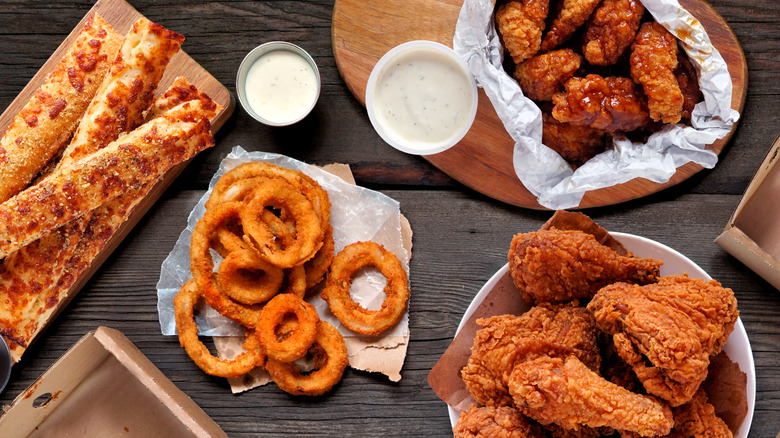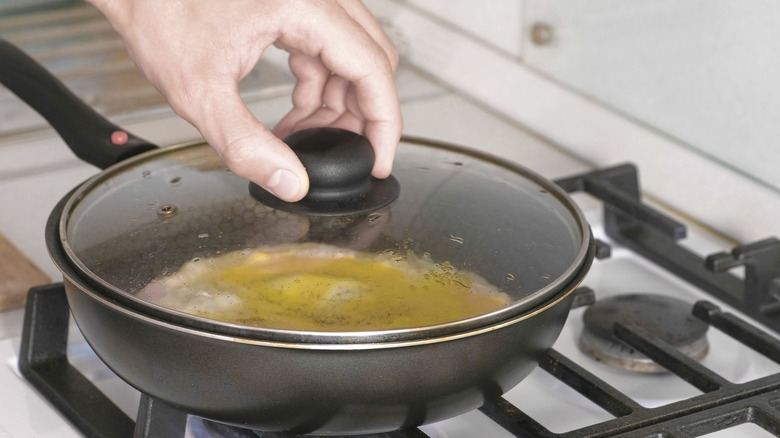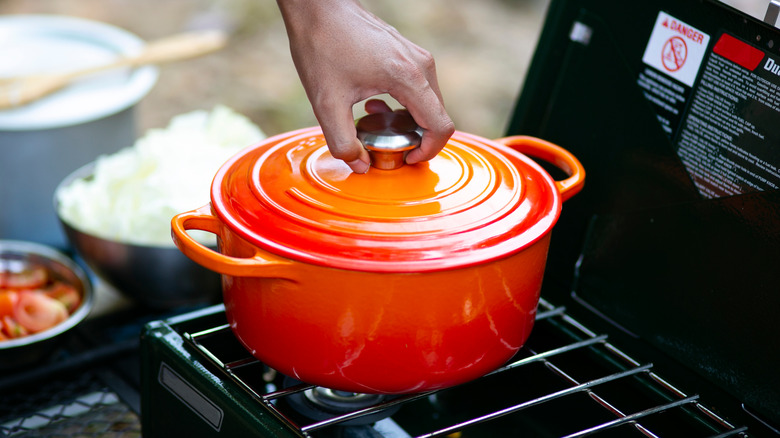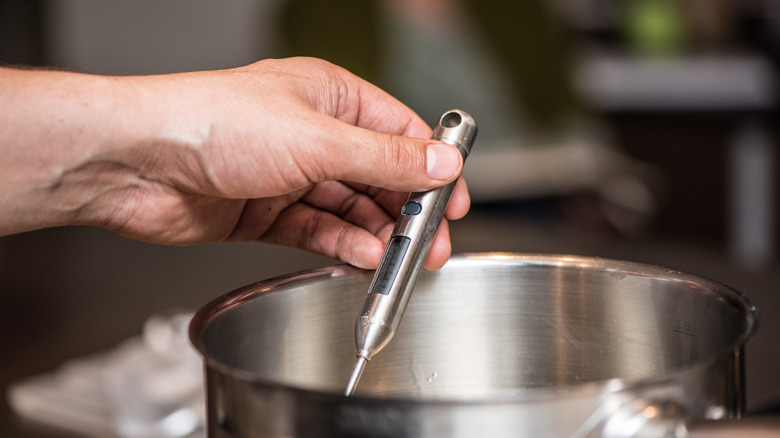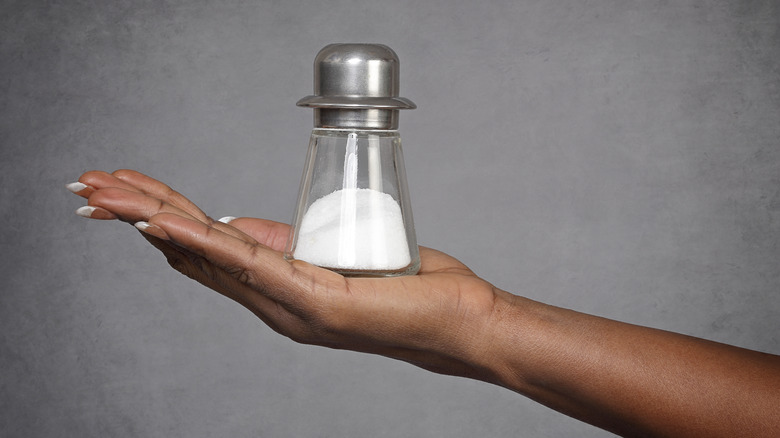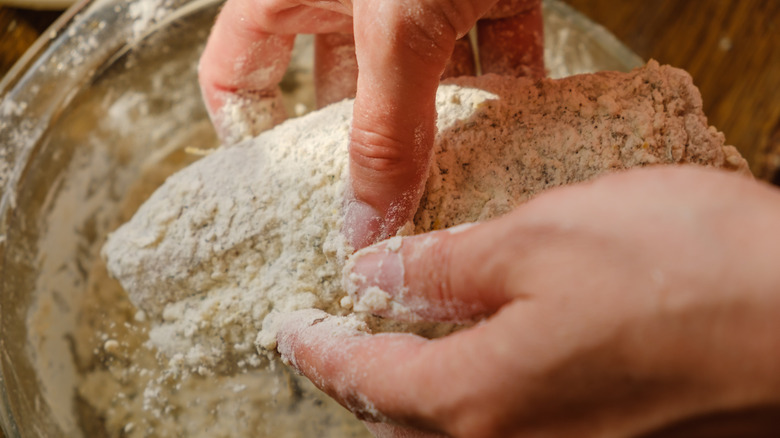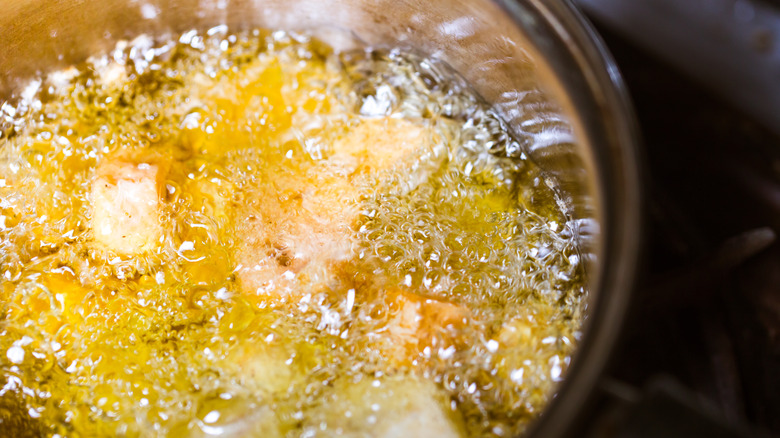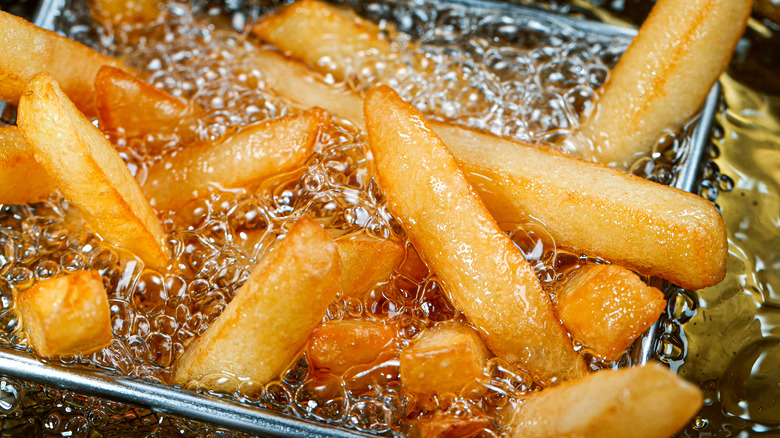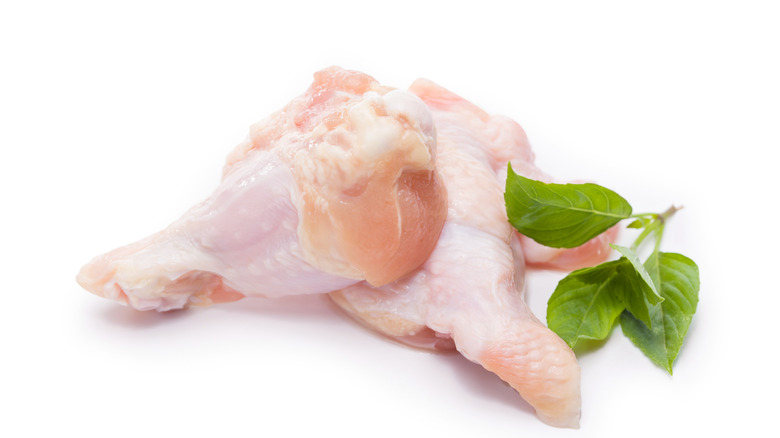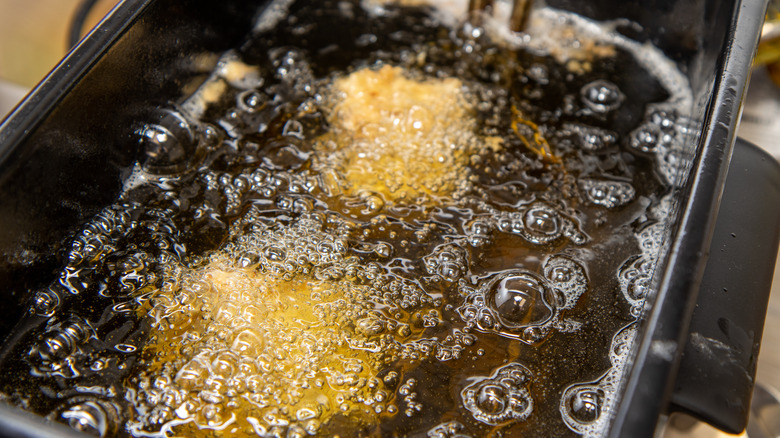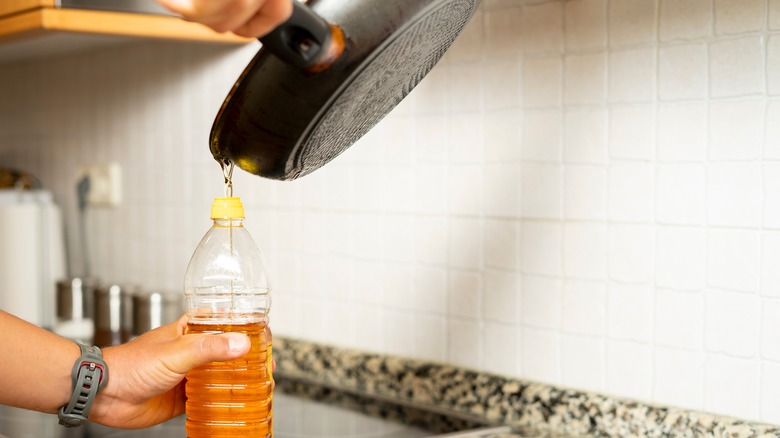Mistakes Everyone Makes When Frying Food
Don't let deep-fried faves like mozzarella sticks, French fries, and crispy fried chicken remain solely in the purview of your local sports bar! Despite what you may have been led to believe, these and more are well within your reach at home. It's understandable if you've been wary thus far. Deep-frying can seem messy, overly complicated, or even dangerous. Luckily, there are a few tips and tricks that can bring fried foods comfortably home without resorting to poor substitutes care of your air fryer. (We love air fryers ... but let's not pretend that air-fried chicken is the same as "real fried chicken.")
To bring frying home, though, you must avoid a handful of frequent missteps that can quickly turn your fried food fête into a fiasco. From oil choice to temperature, from safety precautions to quality control, there are some mistakes that nearly everyone makes when frying food. But luckily, most of these are easily avoided.
Not taking the proper safety precautions before you begin
Safety is one of the most important concerns to grapple with before you even attempt deep-frying at home. Hot oil bubbling on the stovetop could be a recipe for disaster if you're not prepared for the worst! Luckily, we've got a few ways you can make this easier and safer for all involved.
First off, if there are small kids in your home, make sure they're otherwise engaged before you begin. You want your whole focus to be on frying, not on curious little hands! The BBC suggests making the kitchen a kid-free zone during frying, and you'll also want to turn panhandles away from the front of the range. You want to do this not only to keep small fingers from accidentally pulling the pan off the stove, but also to prevent adults from accidentally jostling or knocking the pan.
Before you start cooking, set a well-fitting lid nearby, which will help you extinguish a fire if needed. (Water, in the case of a grease fire, is far more of a danger!) Just One Cookbook notes that you should give frying your full attention. Leaving frying food alone could cause the oil to overheat, contributing to a higher risk of smoke or fire. (Not to mention burning the food, which, while not nearly as dangerous, is far from appetizing!)
Using the wrong pan for deep-frying
Chefs in a professional kitchen rely on a deep-fryer to help chicken, fries, and more reach crispy perfection, but most home cooks don't have the space for a deep-fat fryer at home. For this reason, a pan is usually the best option. But despite time-honored recipes, that doesn't necessarily mean you have to use a skillet or even a frying pan, no matter how apt its name!
Taste of Home recommends a cast-iron Dutch oven with high sides for deep-frying at home. While such a vessel might look far bigger than you need, choosing a pot like this for deep-frying has loads of benefits. Cast iron, contrary to what you may think, is not a great heat conductor, according to Home Cook World. What it is is an excellent heat retainer, meaning that your oil is less likely to drop in temperature when you add cold food. This translates to crisper, more evenly cooked mozzarella sticks or fish and chips. A Dutch oven is a good choice from a safety perspective, as well: Its high volume capacity means that you don't run the risk of your oil bubbling over the edges as your food fries.
Frying at too low of a temperature
If you fear burning your fried food, it may be tempting to keep the temperature low -– or at least, lower than the recipe says. But for an excellent finished dish, you must be bold. Lowering the temp actually runs the risk of making your food absorb the frying oil rather than, well, frying in it. The result, according to Taste of Home, may be soggy, greasy, and unappetizing food.
To help you hit that perfect temperature, the outlet offers a temperature chart organized by different common fried foods, making it easy to find your target temp. If you're using a pot rather than a tabletop fryer with clear temperature control, be sure to invest in a thermometer and check the heat both before and after adding the food to the oil. As a guideline, you can also keep an eye out for the physical signs that the oil has reached the right temperature (like foods sizzling or floating) or isn't quite there (like sinking or burning), as detailed by Just One Cookbook.
Salting food before deep-frying it
In the case of most cooking, whether sautéing, roasting, or baking, seasoning happens before the food ever goes into the pan or the oven. But when deep-frying, you'll want to turn that norm on its head. According to Food Above Gold, salt can cause the oil to pop, running the risk of burning you as you cook.
Instead, wait until the food you're frying is fully cooked, and transfer it to a pan or paper towel-lined plate to drain. Just make sure you season the food with salt while it's still hot so that it sticks to the still-damp surface. If you wait too long, the salt will fall right off the food and season the plate instead. Of course, you can also season fried food by flavoring the brine, as in this pickle juice fried chicken recipe, or by seasoning the egg wash or batter.
Battering or breading fried food improperly
One of our favorite things about fried food is that delicious crispy coating. How disappointing is it, then, when the outer layer gets greasy, soft, burned, or, perhaps worst of all, just falls right off? To get that golden-brown crust of your dreams, you're either going to want to batter or bread the food. Either way, you're probably going to start with a flour dredge, which, The Spruce Eats notes, will help the batter or breading adhere to the food.
In the case of battering, no matter if you choose a light and crispy batter with sparkling water or a heartier batter with beer, time is of the essence, according to Everyday Food. You'll want to make the batter just before using and set up a station so that you can dip each piece of food into the batter right before adding it to the hot oil, minimizing mess.
Breading is another option for creating a crispy coating that requires three distinct steps. This includes dredging, dipping the food in egg to help the breading adhere, and finally coating it in the breading, which can be made from regular breadcrumbs, panko breadcrumbs, or even seasoned breadcrumbs. Set up a station so that you can carry out all three steps in succession, recommends The Spruce Eats. This will reduce the mess and allow you to create an even, crispy breading.
Attempting to fry wet food
When you add food to a deep fryer (or, for that matter, to a pan) and it immediately begins to spurt, sizzle, and bubble, what you're hearing and seeing is the naturally present moisture quickly evaporating in contact with the hot oil, according to Decoding Delicious. Water boils at 212 ºF, so when you've brought oil to 350 ºF or higher, it's no wonder that the moisture in a given food will quickly heat and turn to vapor once the two come into contact.
While all food contains some water — from a raw potato wedge on its way to becoming a French fry to the beer batter on your fish for fish and chips — deep-frying food that's too wet is not a great idea. Not only will batter or breading not adhere to food that's too wet, but if it isn't patted dry before diving into the hot oil, the splatter and sizzle from overly damp food can easily burn you. It's no wonder that scientists are trying to deter TikTokers from participating in the popular but perilous trend of deep-frying water, the Daily Mail reports.
Overheating frying oil
Frying has to happen at a fairly high temperature. Otherwise, your food will soak up the oil before it has time to cook, leaving it soggy and grease-logged. But that doesn't mean that an even higher temperature will result in other-worldly crispiness! Depending on what you're cooking, you generally won't want to heat your oil higher than 375 ºF, cautions Cooks Illustrated. Any more than that, and the oil may begin to smoke and impart a bitter flavor to your food. Or even worse, it can become carcinogenic, according to The Washington Post.
Different oils reach their smoke point at different times, according to Serious Eats. Deep-frying is usually done with oils with a fairly high smoke point, like peanut or safflower, which gives you a bit of wiggle room in terms of your ideal temperature. But this concern is all the more reason for you to pay close attention to your fried foods as they cook and not to leave the stove for too long.
Not frying foods for long enough
If you're frying potato chips, it's fairly easy to see when they're done just by looking for a color change. But in the case of other foods -– particularly foods that are unpleasant or even dangerous when consumed raw, like chicken -– an external golden brown isn't enough. It's important, instead, to keep track of the time the food has spent in the fryer to ensure it's cooked through before you remove it.
Taste of Home offers guidelines for approximate cooking times for frequently fried foods, ranging from fish to chicken to doughnuts. Of course, timing is only a guideline, particularly since the temperature of the fryer oil can drop when a large quantity of cold food is added. As a secondary means of keeping tabs on the doneness of a given food, the outlet offers the internal temperature you should shoot for, which you can check with a probe thermometer before removing the rest of the batch from the oil.
Overcrowding the frying pan
Successful deep-frying is all about maintaining an even temperature throughout the cooking process, which means that overcrowding the pan is your worst enemy. The reason why is a simple matter of physics. Adding cold food to the hot oil will naturally bring down the temperature -– like adding ice cubes to a warm drink. The more you lower the oil, the longer it takes for it to regain the ideal temperature, and the greater your chance of ending up with food that's greasy instead of crispy.
For this reason, CulinaryLore explains, it's essential to fry in small batches. This will keep the oil temperature from dipping too low, allowing you to maintain the perfect temperature for each batch. If you're frying a lot of food and are worried about the first batches going cold before you've finished, The Spruce Eats suggests placing any cooked food on a cooling rack set over a baking sheet and putting it in a low or warm oven until you've finished frying the rest.
Disposing of oil improperly
When you've finished deep-frying, there's no time to waste when it comes to eating. You'll want to dig in as soon as it's ready, or else the food will become soggy, The Spruce Eats warns. And that timetable is ideal, considering that post-fry cleanup should only take place when the oil has had time to cool down completely.
Oil should always be handled cold, according to Budget Dumpster, and it should never be poured down the drain or flushed down the toilet, lest it clogs up your plumbing! Instead, transfer the oil into a container that can be thrown away. Frying oil can also be reused a few times, provided you have not overheated it. Simply strain it through a fine-mesh sieve or cheesecloth and store it in a container in the fridge. Don't reuse it more than a handful of times, and be sure to always smell it before using it to ensure it hasn't gone rancid. Some cities also allow you to recycle your oil, the outlet notes. Use Recycler Finder to see if there's a convenient drop point near you.
